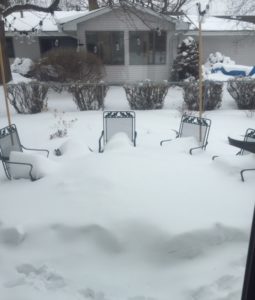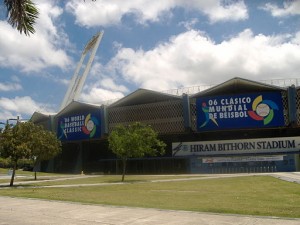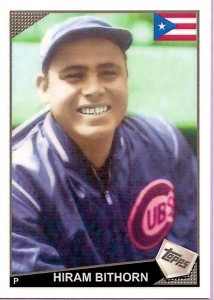Sandy Alomar (Jr. & Sr.), Roberto Alomar, Carlos Baerga, Carlos Beltrán, José Berríos, Orlando Cepeda, Roberto Clemente, Carlos Correa, Carlos Delgado, Francisco Lindor, Javy López, Felix Mantilla (Lamela), Edgar Martínez, Yadier Molina, José Morales, José Pagán, Juan Pizarro, Iván Rodríguez, Eddie Rosario. Those are just a few of the more than 200 Puerto Ricans who have played Major League Baseball. BUT, BEFORE, THEM ALL CAME PUERTO RICO’S FIRST MAJOR LEAGUER – HIRAM BITHORN.
Now, you may wonder why Baseball Roundtable is focusing this post on Hiram Bithorn, particularly since I have touched upon his historic MLB “first” in the past. A confluence of factors contributed to this decision – a perfect storm, if you will.

My patio TODAY … where I should be grilling steaks and listening to the Twins on the radio. Thankfully, they are playing in Puerto Rico.
First, here in Minnesota, we are starving for spring weather – and for baseball. Hit by an historic snowstorm this weekend, we have seen the past three Twins’ home games snowed out. Yes, an April weekend without Twins’ baseball – a shock to the system. We look out our windows now and we see not the green grass upon which the national pastime is played, but 10+ inches of cold, white snow.
Second, thankfully, our Twins are playing the Cleveland Indians in Puerto Rico – where the temperature is expected to reach the mid-80’s and the passion for baseball runs even higher.
Third, the Twins and Indians will be playing in sold out – standing room only –Hiram Bithorn Stadium.
In anticipation of this event – and the return of baseball-watching for Minnesota fans (even if it is just on television) – BBRT would like to present an updated look at Puerto Rican hero Hiram Bithorn.
THE LIFE, TIMES AND MYSTERIOUS DEATH OF HIRAM BITHORN
 Today and tomorrow, the Twins and Indians will be playing in Estadio Hiram Bithorn – Puerto Rico’s largest baseball stadium (18,000 capacity – with a reported 39,000 tickets sold for the two-game set). The ballpark is home to the Santurce Crabbers of the Puerto Rico Baseball League. The ballpark is no stranger to major league ball. Hiram Bithorn Stadium also hosted the opening game of the 2001 Major League season (Texas Rangers vs. Toronto Blue Jays); 44 Montreal Expos home games in the 2003/04 seasons; and, in 2010, a Florida Marlins/New York Mets three-game series.
Today and tomorrow, the Twins and Indians will be playing in Estadio Hiram Bithorn – Puerto Rico’s largest baseball stadium (18,000 capacity – with a reported 39,000 tickets sold for the two-game set). The ballpark is home to the Santurce Crabbers of the Puerto Rico Baseball League. The ballpark is no stranger to major league ball. Hiram Bithorn Stadium also hosted the opening game of the 2001 Major League season (Texas Rangers vs. Toronto Blue Jays); 44 Montreal Expos home games in the 2003/04 seasons; and, in 2010, a Florida Marlins/New York Mets three-game series.
The ballpark is, as noted earlier, named after Hirzam Bithorn – whose major-league career has made him hero in his country and to the Puerto Rican players who followed him to the big league diamonds. So, with the Twins/Indians tilt coming up, let’s take a look at the short baseball career and life of “Hi” Bithorn – who died under mysterious circumstances in Mexico at the age of 35.
Bithorn was born March 18, 1916 in Santurce, Puerto Rico. As he grew up, Bithorn proved a talented athlete. In 1935, the 19-year-old, 6’ 1” 200-pound Bithorn played in the Central American and Caribbean Games on Puerto Rico’s Silver Medal-winning volleyball team and Bronze Medal-winning basketball team. Bithorn’s game, however, was baseball – and he was already making a name for himself on the mound, drawing crowds wherever he unleashed his high leg kick, blazing fastball and effective curve. Note: While Latino players already had appeared in the major leagues, it has been reported that most Puerto Ricans were considered to be too “dark” for the still “all-white” major leagues. The Puerto-Rican born Bithorn, of mixed descent – primarily listed as Dutch and Spanish – was light-skinned and also spoke English.
A rising star on the ball fields of his native country, Bithorn got a chance to show his stuff to a broader audience in 1936, when the Negro League’s Newark Eagles traveled to Puerto Rico for an exhibition series against MLB’s Cincinnati Reds. The Eagles prepared for the Reds’ matchup by playing against local teams – and Bithorn performed well against them. Well enough that when one of their top moundsmen, Leon Day, went down with an illness, the Eagles recruited Bithorn to fill in on their squad. On March 1, 1936 – pitching for the Newark Eagles – Bithorn (then just 20-year-old) faced the National League Cincinnati Reds. He held the Reds to one run over the first seven frames, but had to be relieved when he ran into trouble in the eighth. Still, Newark won the game and Bithorn made enough of an impression that the 1937 season saw him pitching in the Yankees’ farm system.
He went 16-9 in his first season (with the Norfolk Tars of the Class B Piedmont League) and started 1937 with ten wins against just one loss at Norfolk, before being promoted to Binghamton Triplets of the Class A NY/Penn League – where he won seven more games (against eight losses).
Bithorn continued his move toward the major leagues, playing with Oakland Oaks and Hollywood Stars of the then AA Pacific Coast League, where his best season was 1941, when he went 17-15, 3.59 with 16 complete games and two shutouts for the Stars (while also hitting .286 in 77 at bats).
During his stint in the Pacific Coast League Hiram Bithorn picked up the nickname “The Tropical Hurricane.”
 Unfortunately, for Bithorn, the Yankees were loaded with talent and the big leagues seemed far away – until the Cubs acquired him from the Bronx Bombers in the fall of 1941. On April 15, 1942, Bithorn became the first Puerto Rican to appear in a major league game, pitching two scoreless innings in relief (no-hits, one walk, no strikeouts) for the Cubs against Cardinals in Saint Louis. He ended the season 9-14, with two saves, a 3.68 ERA and nine complete games in sixteen starts (Bithorn also made 22 relief appearances) for the sixth-place Cubs.
Unfortunately, for Bithorn, the Yankees were loaded with talent and the big leagues seemed far away – until the Cubs acquired him from the Bronx Bombers in the fall of 1941. On April 15, 1942, Bithorn became the first Puerto Rican to appear in a major league game, pitching two scoreless innings in relief (no-hits, one walk, no strikeouts) for the Cubs against Cardinals in Saint Louis. He ended the season 9-14, with two saves, a 3.68 ERA and nine complete games in sixteen starts (Bithorn also made 22 relief appearances) for the sixth-place Cubs.
While playing professional ball in the United States, Bithorn would return to Puerto Rico to play in the Winter League for the San Juan Senators – who made the 22-year-old Bithorn the team’s manager during the 1938 season.
In 1942, Bithorn showed his full potential. With the Cubs finishing fifth (74-79), Bithorn went 18-12, 2.60, with 19 complete games (30 starts) and a league-leading seven shutouts. For the season, Bithorn, in fact, finished in the NL’s top ten in wins, winning percentage, earned run average, WHIP, innings pitched, strikeouts, complete games and shutouts. Clearly, Bithorn was on his way – until World War II intervened and Bithorn lost two MLB seasons to military service.
BASEBALL ROUNDTABLE ALL-TIME PUERTO-RICAN MLB SQUAD
C – Iván Rodríguez
1B – Orlando Cepeda
2B – Roberto Alomar
3B – Edgar Martínez
SS – Francisco Lindor
LF – Carlos Beltrán
CF – Bernie Williams
RF – Roberto Clemente
DH – Carlos Delgado
SP – Javier Vázquez
RP – Roberto Hernández
Bithorn was discharged from the service in September of 1945 and pitched for San Juan in the Puerto Rican championships the following February, where he suffered a hand injury during a play at the plate. As a result, he reported late for Cubs’ Spring Training. Bithorn reportedly had gained about 20 pounds, was having arm problems and didn’t seem to have the same “stuff” as he displayed in that successful 1943 season. The then 30-year-old finished the 1946 season 6-5, 3.84 in 26 games (seven starts). He was sold to the Pirates in January 1947 and selected on waivers (from the Pirates) by the White Sox before the 1947 season opened. He pitched just two innings in relief for the White Sox – picking up what was to be his last major league win.
CATCHER COUNTRY …
Here are just a few of the major-league catchers from Puerto Rico: Iván Rodríguez; Jorge Posada; Yadier Molina; Sandy Alomar, Jr.; Benjie Molina; Geovany Soto. Martín Maldanado; Christian Vazquez; Héctor Ortiz; Héctor Villaneuva; Orlando Mercado.
After his release, Bithorn underwent surgery and missed the 1948 season. He attempted a comeback in 1949, going 4-3 in 13 games at AA Nashville and Oklahoma City. He did not make it back to the major leagues and finished with a MLB line of 34-31, with 5 saves and a 3.16 ERA in 105 games. In his four MLB seasons, Bithorn completed 30 of 53 starts, with eight shutouts.
AN UNTIMELY DEATH
In December of 1952, at the age of 35, Bithorn was shot to death by a police officer under mysterious circumstances in El Mante, Mexico. Various reports indicate the date of his death as anywhere from December 27, 1951 to January 1, 1952. They indicate Bithorn was on his way to visit his mother Mexico (some reports also say he was considering a comeback in the Mexican League). Initial reports said Bithorn had been trying to sell his car when Ambrosio Castillo Cano of the El Mante police force questioned Bithorn and found him unable to produce the paperwork required of such a sale. Cano reported that, at some time during the questioning, Bithorn became violent and he was forced to shoot him. (Bithorn died a few hours later of a gunshot wound to the stomach). Cano also reportedly said Bithorn admitted to being part of a “communist cell.” The details of the incident remain mysterious, but after an investigation, Cano was indicted and sentenced to eight years in the state prison for Bithorn’s homicide.
In 1962, Bithorn’s status as Puerto Rico’s first major-leaguer was honored with the naming of Hiram Bithorn Stadium.
Primary Resources: Society for American Baseball Research; Baseball-Reference.com; Early Latino Ballplayers in the United States, Nick Wilson, 2005).
I tweet Baseball @DavidBBRT
Follow/Like the Baseball Roundtable Facebook page here.
Member: Society for American Baseball Research; The Baseball Reliquary; The Negro Leagues Baseball Museum.





